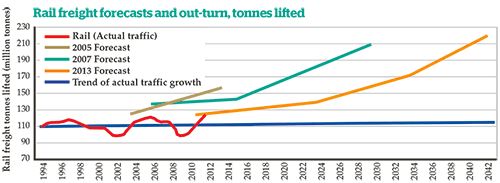So there’s room in the market for more than the current rail freight portfolio of a) bulk; b) intermodal; c) not interested - not in any way to supplant a or b, but more to allow c to be unlocked.
Enter (stage left) the premium freight market. What do I mean by premium? I mean that sub-section of the general merchandise market where speed and reliability have as much of an influence as price in deciding which mode to use. At the global level, shippers will pay airlines such as BA an average of £900 per tonne to fly time-sensitive and/or perishable products around the world as the quickest option available, despite the enormous size of its carbon footprint. At the local level, a courier might charge £100 to make a same-day delivery within the UK for a package weighing less than one kilogram, the (theoretical) equivalent of £10,000 per tonne.
The explosion of online commerce has created a stampede to stay ahead of customer expectations. Once broadband speeds allowed us to order things more quickly online than going off to the shops, we stopped going to the shops as much. Once Next started offering ‘order tonight for delivery tomorrow’ we then expected all the other retailers to do likewise, which they promptly did (or at least tried to). Now Currys, Argos et al offer ‘click now and collect within the hour’, with some parts of the country now being offered same-day delivery for those prepared (impatient) enough to pay a premium for the privilege.
Behind the scenes, the continued rush towards same-day fulfilment creates enormous pressures on the supply chain. As neither the road network nor fleets of drones can move sufficient volumes at sufficient speeds to keep up with orders, so the retailers have no choice but to increase stockholding as close to the customers as possible, to make sure that when Mrs Miggins places her order, there’s enough held locally to fulfil the same-day promise.
Hold too little stock and you might lose Mrs Miggins’ custom to a rival. Hold too much and you’ll end up having to sell it off cheap or throw it away. Customers are sufficiently fickle not to care what impact their selfish, self-centred buying habits are having on logisticians. More by luck than intent, some of those hard-pressed logisticians are now starting to become aware of something they never knew they could have - a high-speed, low-carbon route to market, something that as train passengers we often take for granted.
When paired with suitable road delivery vehicles at one or both ends of the rail haul, the same seamless door-to-door service can be provided to customers as provided by existing road hauliers - the difference is the speed of transit over the primary ‘trunk’ haul, as well as the scope for significant reductions in emissions.
Into this definition of premium freight I’m also going to include TOC passenger luggage, as there’s little to distinguish the service requirements of a suitcase to those of an internet purchase - both need to arrive quickly and intact at the other end, and be capable of tracking throughout.
Anyone who has used the rail network at Christmas, Easter, summer or any Bank Holiday will be aware of the growing volume of luggage that has to find space on the train, to the point where at times it threatens to overwhelm the above-seat and end-of-coach racks, as well as any available space in power cars and DVTs (not available in IEPs).
The ability to intercept a passenger’s luggage before they even leave home (or worst case before they board the train) and route it in parallel to their destination may become increasingly important in the face of continued passenger growth. It may simply be good fortune that there hasn’t been a major incident where luggage has been a contributory factor, either in causing secondary injuries or hindering the evacuation of the train.
Lest we forget, freight secured us high-speed rail services in the first place, courtesy of trains such as the Irish Mail, which launched in 1848. Even today the Royal Mail has been quietly expanding its network of 100mph services back onto the East Coast Main Line alongside its core West Coast Main Line service.
However, to fully tap into and unlock the premium freight market, a headline 100mph top speed isn’t going to cut it when in practice that translates into a 40mph average, even if this still beats the 30mph that a classic freight train or an articulated lorry could achieve over the same medium to long-distance hauls.
Recent trials have proved that rail can deliver a high-speed service between city centres for both individual parcels as well as for trainload volumes. Five years of running with East Midlands Trains, as well as the recent pilot with Great Western Railway, demonstrates the ability for TOCs to support a high-speed (up to 125mph), high-frequency service for small-volume freight.
Thus it is now possible to move a parcel from the centre of Leicester to the centre of London at an average speed of 80mph, with multiple services each way per day. Try doing that by road (actually, don’t). Small wonder the service has attracted everything from documents to medical deliveries, saving lives as well as saving time.












